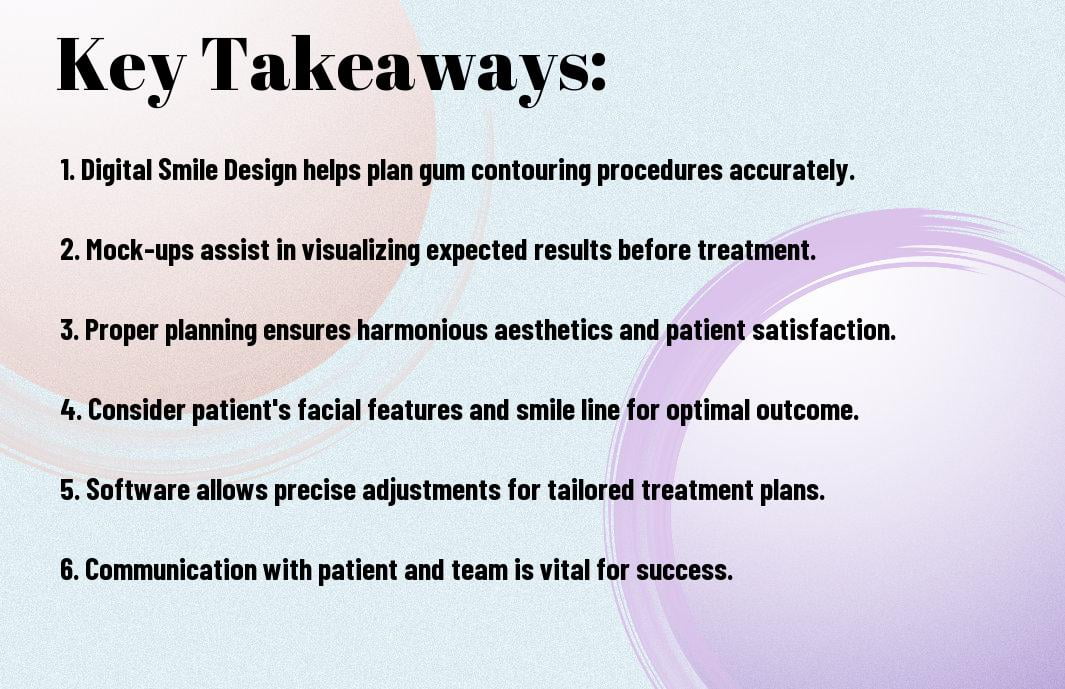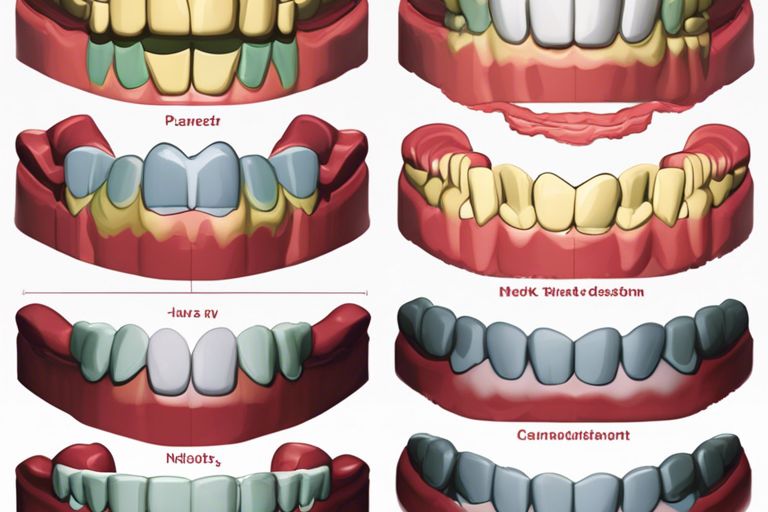Most dental professionals aim for precision and aesthetic perfection when planning gum contouring procedures. In this informative guide, you will explore the advanced techniques of Digital Smile Design and Mock-ups to create a detailed roadmap for achieving optimal patient outcomes. By understanding the intricacies of digital planning and utilizing mock-ups, you can enhance your skills and ensure patient satisfaction with every gum contouring procedure. Let’s research into the world of dental aesthetics and elevate your practice to new heights.
Key Takeaways:
- Digital Smile Design (DSD) is crucial: Using DSD technology allows for precise planning of gum contouring procedures, enhancing accuracy and visualization of the final outcome.
- Mock-ups aid in patient communication: Creating mock-ups enables patients to see potential results beforehand, facilitating informed decision-making and aligning expectations.
- Customization is key: Tailoring gum contouring procedures to each patient’s unique needs and desires ensures optimal outcomes and patient satisfaction.

Fundamentals of Gum Contouring
Definition and Purpose
A key aspect of your planning for gum contouring procedures is understanding the fundamentals of this technique. Gum contouring, also known as gum reshaping or tissue sculpting, is a cosmetic dental procedure aimed at improving the symmetry and overall appearance of your patient’s smile. The purpose of this procedure is to reshape and resize the gums to create a more harmonious balance between the teeth and gums, enhancing the aesthetic appeal of the smile.
Indications and Contraindications
When considering gum contouring for your patient, it’s crucial to recognize the indications and contraindications associated with this procedure. Indications for gum contouring include correcting a gummy smile, uneven gum line, or excessive gum tissue covering the teeth. On the other hand, contraindications may include severe periodontal disease, inadequate attached gingiva, or unrealistic patient expectations.
Any decision to proceed with gum contouring should be based on a comprehensive evaluation of your patient’s dental and periodontal health. It’s imperative to assess the underlying causes of the aesthetic concerns and ensure that the patient understands the goals and limitations of the procedure. Collaborating with a periodontist or a specialist in gum contouring can provide valuable insights and expertise to optimize the outcomes for your patient.
The careful consideration of indications and contraindications in gum contouring is important to ensure successful outcomes and patient satisfaction. By thoroughly assessing each case and customizing your approach based on individual needs, you can achieve aesthetically pleasing results while maintaining the overall health of the oral tissues. Keep in mind, patient education and communication are key components in guiding your decision-making process and managing expectations throughout the treatment journey.
Digital Smile Design
Little did you know that digital smile design can revolutionize your approach to gum contouring procedures. By incorporating digital technologies into your practice, you can create precise treatment plans and stunning outcomes tailored to each patient’s unique smile. Let’s examine into how this innovative approach can enhance your treatment processes.
Overview of Digital Smile Design
Designing a smile digitally allows you to visualize and plan the gum contouring procedure accurately before even starting treatment. By analyzing facial features, tooth alignment, and gum levels, you can craft a customized treatment plan that ensures optimal aesthetics and functionality. With digital smile design, you can involve your patients in the decision-making process, showing them realistic mock-ups of their potential outcomes.
Software and Tools Used
Digital smile design utilizes specialized software and tools to create comprehensive treatment plans. These advanced technologies allow you to manipulate digital images of your patient’s smile, adjusting gum levels, tooth shape, and overall aesthetic harmony with precision. By utilizing these tools, you can fine-tune every aspect of the gum contouring procedure, ensuring the best possible results for your patients.
Overview: When incorporating digital smile design into your practice, you gain access to powerful software and tools that streamline the treatment planning process. These digital solutions offer detailed visualization capabilities, allowing you to design precise mock-ups and communicate effectively with your patients.
Creating a Virtual Mock-up
Digital smile design facilitates the creation of virtual mock-ups that showcase the potential outcomes of gum contouring procedures. By generating realistic digital representations of the final results, you can demonstrate to your patients the transformative effects of the treatment. This visualization tool not only helps in treatment planning but also in setting accurate patient expectations and ensuring satisfaction with the final results.
Mockup: Utilizing digital technologies to create virtual mock-ups is a game-changer in the field of gum contouring procedures. These visual aids allow you to present realistic previews of the anticipated outcomes, fostering patient engagement and confidence in the proposed treatment plan.
Importance of Mock-ups in Gum Contouring
Visualizing Treatment Outcomes
All successful treatments start with a clear vision of the desired outcomes. By creating mock-ups of gum contouring procedures using advanced tools like Digital Smile Design, you can accurately visualize how the final result will look. This not only helps you plan the treatment more effectively but also gives your patients a tangible preview of the transformation they can expect.
Patient Communication and Education
Treatment planning in gum contouring is not just about the technical aspects; it’s also about ensuring your patients understand the process and outcomes. By presenting them with mock-ups, you can effectively communicate the changes that will occur, manage expectations, and address any concerns or desires they may have regarding their smile.
A well-crafted mock-up serves as a powerful educational tool, allowing patients to see and feel the potential results before committing to the actual procedure. This level of engagement can lead to increased patient satisfaction and confidence in your recommendations.
Treatment Planning and Refinement
Any successful gum contouring procedure requires meticulous planning and fine-tuning. Mock-ups play a crucial role in this stage by allowing you to assess different options, make precise adjustments, and perfect the treatment plan before implementation. By analyzing mock-ups alongside your patient, you can collaboratively refine the design to achieve the optimal aesthetic outcome.
It is vital to involve your patients in the treatment planning process, as their feedback and preferences are integral to tailoring the gum contouring procedure to their unique needs and desires. Utilizing mock-ups ensures that both you and your patient are aligned in the treatment goals, resulting in a more satisfying and successful outcome.
Clinical Considerations for Gum Contouring
Anatomical Factors
Keep in mind that the anatomy of the patient’s oral cavity plays a crucial role in planning gum contouring procedures. Factors such as the position of the teeth, the shape of the alveolar process, and the thickness of the soft tissues will all impact the outcome of the treatment. Assessing these anatomical factors through thorough examination and imaging techniques will help you create a precise treatment plan tailored to each patient’s unique oral structure.
- Consider the position of the patient’s teeth in relation to the overall esthetics of their smile
- Assess the shape of the alveolar process to determine the extent of bone support for the soft tissues
- Evaluate the thickness of the patient’s soft tissues to anticipate the potential for tissue recontouring
After evaluating these anatomical factors, you can create digital smile mock-ups to visualize the expected changes in gum contours and guide your treatment approach effectively.
Periodontal Health and Status
Status
Another vital aspect to consider before performing a gum contouring procedure is the patient’s periodontal health and status. Conduct a comprehensive periodontal assessment to evaluate the condition of the gums, the presence of any periodontal disease, and the level of attachment loss. This information is crucial in determining the feasibility of gum contouring and ensuring that the procedure will not compromise the patient’s periodontal health.
Occlusal Analysis and Impact
Health
To ensure successful outcomes of gum contouring procedures, you must assess the patient’s occlusal relationships and how they might be impacted by changes in gum contours. Analyze the patient’s bite, tooth alignment, and functional movements to anticipate any potential occlusal issues that may arise post-procedure. This comprehensive evaluation will help you plan the gum contouring effectively while maintaining the patient’s occlusal stability and function.
Integrating Digital Smile Design with Clinical Evaluation
Unlike traditional methods of planning gum contouring procedures, integrating Digital Smile Design (DSD) with clinical evaluation allows for a more comprehensive and precise approach. By combining virtual simulations with hands-on assessments, you can create a customized treatment plan that addresses the patient’s unique needs and desires.
Combining Virtual and Clinical Assessments
Assessments that merge digital tools like DSD with clinical evaluations provide a holistic view of the patient’s oral health. Through this integrated approach, you can analyze the aesthetic and functional aspects of the smile, ensuring that the final treatment plan meets both cosmetic and practical goals. By comparing the virtual mock-ups with the patient’s actual dental structures, you can tailor the gum contouring procedure to achieve optimal results.
Identifying Discrepancies and Adjusting Treatment Plans
To guarantee the success of your gum contouring procedure, it is crucial to identify any discrepancies between the digital designs and the clinical findings. By closely examining these variations, you can adjust your treatment plan accordingly to ensure that the final outcomes align with the patient’s expectations. This meticulous approach helps in minimizing potential surprises and ensures a more predictable and satisfactory result for your patients.
Evaluation of the virtual mock-ups in comparison to the patient’s actual smile is necessary for detecting any discrepancies that may arise during the treatment process. By carefully analyzing these differences, you can make necessary adjustments to the treatment plan, ensuring that the final outcomes meet the patient’s aesthetic and functional goals. This proactive approach can enhance the overall success and satisfaction of the gum contouring procedure.
Enhancing Patient Satisfaction and Trust
Digital Smile Design not only helps in creating precise treatment plans but also plays a significant role in enhancing patient satisfaction and trust. By involving patients in the design process and allowing them to visualize the potential outcomes, you can cultivate a sense of trust and confidence in the proposed treatment. Additionally, by aligning the final results with the initial virtual mock-ups, you can increase patient satisfaction and build long-lasting relationships based on transparency and accountability.
Identifying discrepancies between the virtual designs and clinical evaluations is crucial for maintaining patient trust and satisfaction throughout the gum contouring procedure. By addressing any deviations early on and adjusting the treatment plan accordingly, you can ensure that the patient’s expectations are met consistently. This meticulous attention to detail not only enhances the treatment outcomes but also fosters a strong patient-dentist relationship built on transparency and mutual understanding.
Advanced Techniques and Innovations
- 3D Printing and Guided Surgery
Not only can 3D printing technology help in creating accurate models for your gum contouring procedures, but it can also assist in guided surgery. By utilizing 3D printed models, you can plan and execute your gum contouring with precision and efficiency.
3D Printing and Guided Surgery
The incorporation of 3D printing technology in gum contouring procedures has revolutionized the precision and predictability of such treatments. By using 3D printed models, you can plan the exact amount of tissue recontouring needed before the actual procedure. This technology enables you to optimize the outcome for your patients, ensuring precise and personalized results.
- Laser-Assisted Gum Contouring
On the forefront of innovative techniques is laser-assisted gum contouring. This cutting-edge approach allows for more precise tissue removal and reshaping, resulting in minimal discomfort and faster healing times for your patients.
Laser-Assisted Gum Contouring
The utilization of lasers in gum contouring procedures offers numerous benefits, including enhanced precision, reduced bleeding, and decreased post-operative discomfort. By incorporating laser technology into your practice, you can achieve exceptional results while ensuring a comfortable experience for your patients.
- Emerging Trends and Future Directions
With advancements in technology and research, emerging trends in gum contouring procedures are constantly evolving. Stay informed about the latest innovations and techniques to provide the best possible care for your patients.
Emerging Trends and Future Directions
With a focus on patient-centered care and technological advancements, the future of gum contouring procedures is promising. Emerging trends such as minimally invasive techniques and digital treatment planning are shaping the way these procedures are performed. By staying abreast of these developments, you can enhance the quality of care you provide and stay at the forefront of your field.
Summing up
Planning gum contouring procedures using Digital Smile Design and Mock-ups can greatly benefit your practice by providing a visual guide for both you and your patients. These tools allow you to precisely design and communicate the desired outcome before beginning any treatment, ensuring optimal results and patient satisfaction.
By incorporating these modern technologies into your practice, you can enhance your treatment planning process, increase patient trust, and ultimately achieve better aesthetic and functional outcomes. So, embrace the power of Digital Smile Design and Mock-ups to revolutionize your gum contouring procedures and elevate the standard of care you provide to your patients.
FAQ
Q: What is the purpose of planning gum contouring procedures in Digital Smile Design and Mock-ups?
A: The purpose of planning gum contouring procedures in Digital Smile Design and Mock-ups is to achieve optimal aesthetics and functionality in a patient’s smile. By digitally designing the new smile and creating mock-ups, dental professionals can visualize and plan the gum contouring procedure to enhance the overall harmony of the smile.
Q: How does Digital Smile Design contribute to the planning of gum contouring procedures?
A: Digital Smile Design plays a crucial role in the planning of gum contouring procedures by allowing dental professionals to digitally design the desired smile transformation. By incorporating the patient’s facial features and preferences, dentists can create a customized smile design that serves as a blueprint for the gum contouring process, ensuring precise and satisfactory results.
Q: What are the benefits of utilizing mock-ups in the planning of gum contouring procedures?
A: Mock-ups serve as a valuable tool in the planning of gum contouring procedures as they allow patients to preview the proposed changes to their smiles before undergoing any permanent alterations. This not only helps in managing patient expectations but also enables dentists to make any necessary adjustments to the gum contouring plan based on the patient’s feedback, resulting in a more successful and satisfying outcome.






